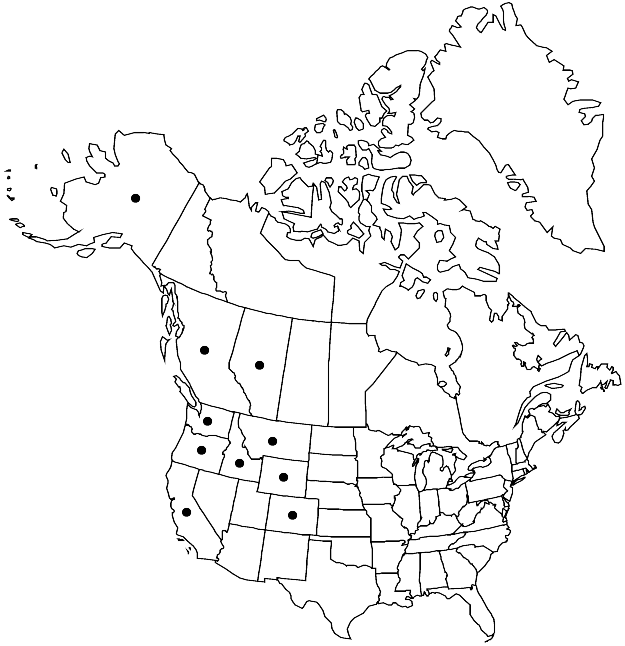Homalothecium aeneum
Bull. Torrey Bot. Club 92: 351. 1965.
Plants medium-sized, in dense tufts, light green when young, golden or brownish yellow with age. Stems to 10 cm, densely regularly pinnate, branches 5–7 mm, curved to almost circinate, secund from substrate. Stem-leaves erect-appressed, triangular-lanceolate, (0.7–) 1.5–2 (–2.8) × (0.2–) 0.5–0.7 (–0.8) mm; base short-rounded, narrowly decurrent; margins plane or often recurved in places, serrulate or subentire; apex acuminate or gradually tapered; costa to 70–95% leaf length, terminal spine present; alar cells ovate, 6–7 µm wide, walls thick, region of 5–10 × 6–10 cells, moderately distinctly delimited, opaque to moderately translucent; laminal cells linear-flexuose, 30–85 × 5–6 µm; basal-cells irregularly long-ovate, region in 1–3 rows, indistinctly delimited from distal cells. Branch leaves appressed when dry, spreading when moist, narrowly lanceolate, (0.5–) 0.7–1.8 × (0.1–) 0.2–0.4 mm; margins plane or recurved at places, serrulate or serrate proximally, entire or minutely serrulate distally, teeth recurved in alar region; apex acuminate; costa to 70–95% leaf length, variable within one shoot, terminal spine present; alar cells subquadrate or irregularly ovate, 7–10 µm wide, walls moderately incrassate, region small, of 5–10 cells along submarginal fold, distinctly delimited; laminal cells linear-flexuose, 25–85 × 4–6 µm; basal-cells in 1 (or 2) rows; distal cells smooth. Sexual condition phyllodioicous or dioicous. Seta 0.7–1.5 cm, rough proximally to almost throughout or smooth distally. Capsule inclined to horizontal, occasionally suberect, ovate-cylindric, curved, 1.8–2.5 mm; annulus separating by fragments; operculum long-conic; peristome hygrocastique; exostome teeth with long transitional zone; endostome basal membrane 40% endostome height, segments as long as exostome teeth, narrow, cilia almost as long as segments. Spores 10–17 µm.
Habitat: Calcareous rock, sandstone, granite, soil, rotten logs, tree trunks, forests, open areas
Elevation: low to high elevations (0-2300 m)
Distribution

Alta., B.C., Alaska, Calif., Colo., Idaho, Mont., Oreg., Wash., Wyo.
Discussion
H. Hofmann (1998) suggested treating Homalothecium aeneum as a subspecies of H. nevadense, but D. H. Norris and J. R. Shevock (2004) did not accept this decision. Analysis by S. Huttunen et al. (2008) and L. Hedenäs et al. (2009) found the two species closely related, but sufficiently distinguished to be treated as separate. The ranges of both taxa are almost identical, although H. aeneum is more common in the northern part of their range and H. nevadense in the south. The two species are distinguished mainly by sporophytic characters, and sterile collections are usually difficult to interpret. Hofmann (1997, 1998) and Norris and Shevock considered the main distinguishing character to be that H. aeneum has alar cells more numerous, regular in shape, with clear outlines and not opaque, whereas H. nevadense has fewer alar cells, irregular in shape, with unclear outlines and appearing opaque. The difference in cell shape is here confirmed, while variation in number of cells seems difficult to apply as the broader leaves of H. nevadense from better developed plants have a fairly extensive alar group.
Selected References
None.
Lower Taxa
"long" is not a number."broad" is not a number.